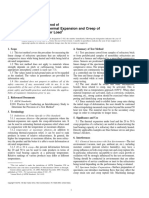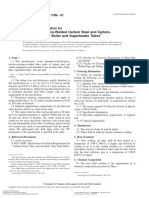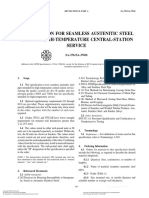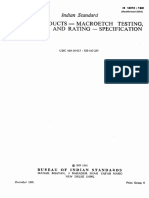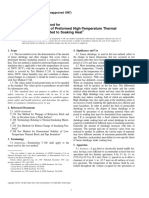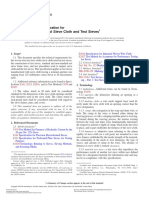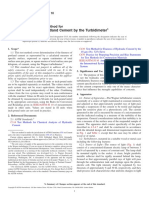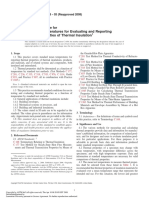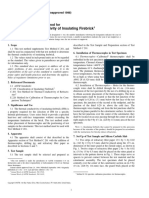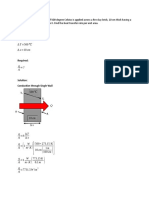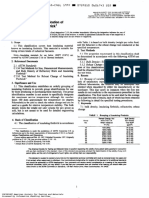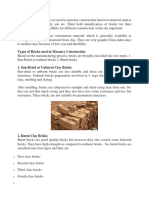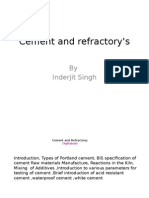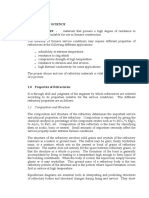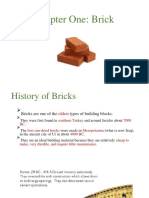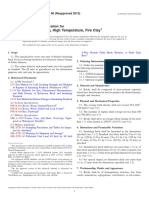Astm C201
Astm C201
Uploaded by
Cesar BernalCopyright:
Available Formats
Astm C201
Astm C201
Uploaded by
Cesar BernalOriginal Title
Copyright
Available Formats
Share this document
Did you find this document useful?
Is this content inappropriate?
Copyright:
Available Formats
Astm C201
Astm C201
Uploaded by
Cesar BernalCopyright:
Available Formats
Designation: C 201 – 93 (Reapproved 2004)
Standard Test Method for
--`,,,`,,-`-`,,`,,`,`,,`---
Thermal Conductivity of Refractories1
This standard is issued under the fixed designation C 201; the number immediately following the designation indicates the year of
original adoption or, in the case of revision, the year of last revision. A number in parentheses indicates the year of last reapproval. A
superscript epsilon (e) indicates an editorial change since the last revision or reapproval.
1. Scope 3. Significance and Use
1.1 This test method covers the determination of the com- 3.1 The thermal conductivity of refractories is a property
parative thermal conductivity of refractories under standard- required for selecting their thermal transmission characteris-
ized conditions of testing. This test method is designed for tics. Users select refractories to provide specified conditions of
refractories having a conductivity factor of not more than 200 heat loss and cold face temperature, without exceeding the
Btu·in./h·ft2·°F (2818 W/m·K), for a thickness of 1 in. (25 mm). temperature limitation of the refractory. This test method
1.2 Detailed ASTM test methods to be used in conjunction establishes the testing for thermal conductivity of refractories
with this procedure in testing specific types of refractory using the calorimeter.
materials are as follows: Test Method C 182, Test Method 3.2 This procedure requires a large thermal gradient and
C 202, Test Method C 417, and Test Method C 767. steady state conditions. The results are based upon a mean
1.3 The values stated in inch-pound units are to be regarded temperature.
as the standard. The values in parentheses are provided for 3.3 The data from this test method are suitable for specifi-
information only. cation acceptance, and design of multi-layer refractory con-
1.4 This standard does not purport to address all of the struction.
safety concerns, if any, associated with its use. It is the 3.4 The use of these data requires consideration of the actual
responsibility of the user of this standard to establish appro- application environment and conditions.
priate safety and health practices and determine the applica-
bility of regulatory limitations prior to use. 4. Apparatus
4.1 The apparatus shall conform in close detail with that
2. Referenced Documents shown in the approved drawings.3 The equipment is shown in
2.1 ASTM Standards: 2 Fig. 1 and Fig. 2, and the essential parts are as follows:
C 134 Test Methods for Size, Dimensional Measurements, 4.1.1 Heating Chamber—A heating chamber, shown in Fig.
and Bulk Density of Refractory Brick and Insulating 3, shall be capable of being heated electrically over a tempera-
Firebrick ture range from 400 to 2800°F (205 to 1540°C) in a neutral or
C 155 Classification of Insulating Firebrick oxidizing atmosphere. The temperature of the heating unit shall
C 182 Test Method for Thermal Conductivity of Insulating be controlled by a mechanism capable of maintaining the
Firebrick temperature in the chamber constant to within 65°F (63°C). A
C 202 Test Method for Thermal Conductivity of Refractory silicon carbide slab 131⁄2 by 9 by 1 in. (342 by 228 by 25 mm),
Brick with the 131⁄2 by 9-in. (342 by 228 mm) faces plane and
C 417 Test Method for Thermal Conductivity of Unfired parallel, shall be placed above the sample for the purpose of
Monolithic Refractories providing uniform heat distribution. A layer of insulation
C 767 Test Method for Thermal Conductivity of Carbon equivalent at least to 1 in. (25 mm) of Group 20 insulating
Refractories firebrick (see Classification C 155) shall be placed below the
E 220 Method for Calibration of Thermocouples by Com- calorimeter and guard plates.
parison Techniques 4.1.2 Calorimeter Assembly—A copper calorimeter assem-
bly, of the design shown in Fig. 4, shall be used for measuring
1
the quantity of heat flowing through the test specimen. The
This test method is under the jurisdiction of ASTM Committee C08 on
Refractories and is the direct responsibility of Subcommittee C08.02 on Thermal
Stress Resistance.
3
Current edition approved Sept. 1, 2004. Published October 2004. Originally The complete set of approved drawings necessary for the construction of the
approved in 1945. Last previous edition approved in 1998 as C 201 – 93 (1998). apparatus and suggested operating instructions, each of which requires too much
2
For referenced ASTM standards, visit the ASTM website, www.astm.org, or space to be included with this test method, were originally drafted by the Insulating
contact ASTM Customer Service at service@astm.org. For Annual Book of ASTM Products Division of Babcock and Wilcox Co. ASTM has been advised that these
Standards volume information, refer to the standard’s Document Summary page on drawings are no longer available. Subcommittee C08 .05 currently is taking this
the ASTM website. issue under advisement.
Copyright © ASTM International, 100 Barr Harbor Drive, PO Box C700, West Conshohocken, PA 19428-2959, United States.
Copyright ASTM International 1
Reproduced by IHS under license with ASTM
No reproduction or networking permitted without license from IHS Not for Resale
C 201 – 93 (2004)
4.1.4 Instruments for Measuring Temperature of
Specimen—Calibrated4 thermocouples shall be embedded in
the test specimen for measuring the temperature. The
electromo-tive force (emf) for the temperature readings shall
be taken with a potentiometer having an instrument error of not
more than 60.05 mV, and the cold junctions of the thermo-
couples shall be immersed in a mixture of ice and water.
4.1.5 Instrument for Measuring Temperature Rise in Calo-
rimeter Water—A multiple differential thermocouple shall be
used for measuring5 within an accuracy of not less than 1 % of
the temperature rise of the water flowing through the calorim-
eter. The thermocouple shall be immersed at least 31⁄2 in. (89
mm) in the inlet and outlet connections, and the junctions shall
be not more than 1⁄4 in. (6 mm) distant from the bottom of the
calorimeter. A calibrated differential 10X copper-constantan
thermocouple shall be used, and the millivolt readings shall be
taken with a potentiometer having an instrument error of not
more than 60.01 mV in the range between 0 and 2 mV.
4.1.6 Instruments for Measuring Temperature Difference
Between Calorimeter and Inner Guard—Calibrated differential
10X copper-constantan thermocouples shall be located in the
calorimeter and inner guard for measuring5 the temperature
differences between the calorimeter and inner guard. The
temperature difference during a test shall be maintained at a
value less than 60.05°F (60.03°C). The thermocouple junc-
tions shall be placed in the four wells provided for that
purpose, and millivolt readings shall be taken with a potenti-
ometer having an instrument error of not more than 60.01 mV
in the range between 0 and 2 mV.
NOTE 1—The upper half of the heating chamber has been raised to
5. Test Sample and Its Preparation
permit introduction of the test samples.
FIG. 1 Photograph of Thermal Conductivity Apparatus 5.1 Test Sample—The test sample shall consist of three 9-in.
(228-mm) straight brick and six 9 by 21⁄2 by 21⁄4-in. (228 by 64
by 57-mm) soap brick (Note 2) that are representative of the
material being tested. These brick shall be selected for unifor-
water circulation is such that adjacent passages contain incom- mity of structure and bulk density, and they shall be free of
ing and outgoing streams of water. The calorimeter shall be 3 broken corners or edges. One brick shall be used as the test
by 3 in. (76 by 76 mm) square and shall have one inlet and one specimen, and one each of the other two brick shall be used as
outlet water connection. The inner guard surrounding the guard brick on either side of the specimen. The six soap brick
--`,,,`,,-`-`,,`,,`,`,,`---
calorimeter shall be 131⁄2 by 9 in. (342 by 228 mm) and shall shall be placed around the edges of the test specimen and guard
have two inlet and two outlet water connections. The outer brick to prevent side flow of heat. The test specimen and guard
guard shall extend 2 in. (51 mm) laterally from the inner guard brick shall cover an area of approximately 18 by 131⁄2 in. (456
and shall extend vertically to the member comprising the by 342 mm).
bottom of the heating chamber (see Fig. 3). The separation NOTE 1—A total of nine 9-in. (228-mm) straight brick may be submit-
between the calorimeter and the inner guard shall be 1⁄32 in. (0.8 ted for test, six of which would be cut to obtain the soap brick.
mm).
5.2 Preparation of Test Sample—The 9 by 41⁄2-in. (228 by
4.1.3 Water-Circulating System—A water-circulating sys- 114-mm) faces of the three straight brick and the 9 by 21⁄4-in.
tem shall be provided for supplying the calorimeter assembly (228 by 57-mm) faces of the soap brick shall be ground flat and
with water at constant pressure and at a temperature that is not parallel, and the thickness shall not vary more than 60.01 in.
changing at a rate greater than 1°F (0.5°C)/h. The inlet water (60.3 mm). The thickness shall be not more than 3 (76 mm)
pressure shall be at least the equivalent of 10 ft of hydrostatic nor less than 2 in. (51 mm). The sides that are to be placed in
pressure (29.9 kPa). The inlet water temperature shall at all
times be within +5°F (+3°C) or −2°F (−1°C) of the room
temperature. Fig. 5 shows the arrangement that shall be used 4
Method E 220 specifies calibration procedures for thermocouples.
for meeting these conditions. The regulating valves for con- 5
The following procedures are recommended: Roeser, W. F., “Thermoelectric
trolling the rate of water flow through the calorimeter assembly Thermometry,” and Roeser, W. F., and Wensel, H. T., “Methods of Testing
Thermocouples and Thermocouple Materials,” Temperature, Its Measurement and
shall be capable of maintaining a constant rate of flow within Control, Reinhold Publishing Corp., New York, NY, 1941, pp. 180 and 284,
61 % during the test period. respectively.
Copyright ASTM International 2
Reproduced by IHS under license with ASTM
No reproduction or networking permitted without license from IHS Not for Resale
--`,,,`,,-`-`,,`,,`,`,,`---
C 201 – 93 (2004)
A—Constant-head water supply. J—Microregulating valves.
B—Inlet manifold and thermometer. L—Water-level valve.
C—Circulating pump. M—Magnetic control valve.
D—To drain. N—Outlet manifold.
E—Cooling coil. O—Overflow pipe.
F—Water filter. T—Thermostat (controls M).
G—Center calorimeter. V—Valves.
H—Inner guard calorimeter. W—Water inlet.
I—Outer guard calorimeter.
FIG. 2 Diagram Showing Essential Parts of Thermal Conductivity Apparatus
contact shall be ground flat and at right angles to the 9 by per cubic foot (or kilograms per cubic metre) shall be deter-
41⁄2-in. face of the brick and the 9 by 21⁄4-in. face of the soap mined in accordance with Test Methods C 134, with the
brick. exception that the thickness measurement shall be made in
accordance with those methods.
NOTE 2—Additional instructions are given in the methods of test for
specific materials (see Section 7) concerning the preparation of the
specimen, placing of guard brick, and the like. 7. Procedure
7.1 Use the procedures for testing specific types of refrac-
6. Bulk Density of Test Specimen tory materials as described in the following test methods: Test
6.1 The test specimen shall be dried at 220 to 230°F (105 to Method C 182, Test Method C 202, Test Method C 417, and
110°C) for 12 h, after which time its bulk density, in pounds Test Method C 767.
Copyright ASTM International 3
Reproduced by IHS under license with ASTM
No reproduction or networking permitted without license from IHS Not for Resale
C 201 – 93 (2004)
NOTE 1—When testing insulating firebrick, the back-up insulation is removed.
FIG. 3 Diagrammatic Section Through Heating Chamber
--`,,,`,,-`-`,,`,,`,`,,`---
FIG. 4 Design of Calorimeter and Guard Rings
8. Record of Test Data 8.1.2 Distance between thermocouple junctions located in
8.1 Record the following data, and record 8.1.3 to 8.1.7 for the test specimen,
each 2-h test period (steady state of heat flow): 8.1.3 Three sets of temperature readings as measured by the
8.1.1 Linear dimensions of test specimen, thermocouples in the test specimen,
Copyright ASTM International 4
Reproduced by IHS under license with ASTM
No reproduction or networking permitted without license from IHS Not for Resale
C 201 – 93 (2004)
t1 = higher of two temperatures measured in the test
specimen, °F (or K),
t2 = lower of two temperatures measured in the test speci-
men, °F (or K), and
A = area of center calorimeter, ft 2(or m2).
10. Report
10.1 The report shall include the following:
10.1.1 Brand name or other identifying information,
10.1.2 Bulk density of the dried test specimen (see Section
6),
10.1.3 General description of the test specimen before and
after test with respect to possible structural changes caused by
exposing the test specimen to the heating chamber tempera-
tures.
10.1.4 The thermal conductivity data as calculated in accor-
dance with Section 8 at the mean temperatures recorded during
a 2-h holding period with a steady state of heat flow, and
reported at the mean of the two temperatures used in the
calculation.
10.1.5 A curve showing the actual thermal conductivity
values obtained versus mean temperatures, and
10.1.6 When requested, the data recorded for Section 8 shall
be included in the report.
11. Precision and Bias
C—Circulating pump. L—Water-level valve. 11.1 Interlaboratory Test Data:
--`,,,`,,-`-`,,`,,`,`,,`---
D—To drain. M—Magnetic control valve.
E—Cooling coil. O—Overflow pipe. 11.1.1 Results of round-robin tests between four laborato-
F—Water filter. T—Thermostat (controls M). ries on three varieties of refractory material ranging in k-value
G—Center calorimeter. V—Valves. from 2 to 165 were evaluated.
H—Inner guard calorimeter. W—Water inlet.
I—Outer guard calorimeter. 11.1.2 Polynomial regressions were established by com-
FIG. 5 Water-Circulating System with Automatic Temperature
puter, and the residual sum of squares and degree of freedom
Control were summated for the within-laboratory variances. Between-
laboratory variances were calculated from the regression
curves of the four laboratories at four mean temperatures
(500°F, 1000°F, 1500°F, and 2000°F).
8.1.4 Mean temperature between each pair of thermo- 11.1.3 The components of variance for the thermal conduc-
couples in the test specimen as calculated from the tempera- tivity, k, (Btu·in./h·ft2·°F) expressed as coefficients of varia-
tures recorded in 8.1.3, tions were:
8.1.5 Average rise in temperature of the water flowing Within laboratories, Vw= 3.4 %
through the calorimeter, Between laboratories, Vb= 9.0 %
8.1.6 Average rate of water flow through the calorimeter,
11.2 Precision—For the components of variation given in
and
11.1, two averages of test values will be considered signifi-
8.1.7 Rate of heat flow through the test specimen per unit
cantly different at the 95 % probability level if the difference
area.
equals or exceeds the critical differences listed as follows: (t =
9. Calculation 1.96)
No. of Samples in Each Critical differences, % of grand average k (Btu·in./
9.1 Calculate the thermal conductivity as follows: Average h·ft2·°F)
within-lab between-lab
@k 5 qL /[A~ t1 2 t2!# ( n) precision precision, %
1 9.4 % 26.6
2 6.6 % 25.8
where: 3 5.5 % 25.5
k = thermal conductivity, Btu·in./h·ft 2·°F (or W/m·K), 5 4.2 % 25.0
q = Btu/h flowing into the calorimeter (temperature rise, °F 11.3 Supplemental Interlaboratory Data— One refractory
(K) of the water flowing through the calorimeter times material was tested by four laboratories in which the thermo-
the weight of flowing water, lb/h (or W)), couples were permanently affixed by one laboratory. Polyno-
L = thickness (distance between hot junctions at which t 1
mial regression equations on these data revealed the following
and t2 are measured), in. (or m),
components of variance:
Copyright ASTM International 5
Reproduced by IHS under license with ASTM
No reproduction or networking permitted without license from IHS Not for Resale
C 201 – 93 (2004)
Within laboratories, Vw= 3.1 %
Between laboratories, Vb= 2.3 %
12. Keywords
12.1 calorimeter; refractories; thermal conductivity
ASTM International takes no position respecting the validity of any patent rights asserted in connection with any item mentioned
in this standard. Users of this standard are expressly advised that determination of the validity of any such patent rights, and the risk
of infringement of such rights, are entirely their own responsibility.
This standard is subject to revision at any time by the responsible technical committee and must be reviewed every five years and
if not revised, either reapproved or withdrawn. Your comments are invited either for revision of this standard or for additional standards
and should be addressed to ASTM International Headquarters. Your comments will receive careful consideration at a meeting of the
responsible technical committee, which you may attend. If you feel that your comments have not received a fair hearing you should
--`,,,`,,-`-`,,`,,`,`,,`---
make your views known to the ASTM Committee on Standards, at the address shown below.
This standard is copyrighted by ASTM International, 100 Barr Harbor Drive, PO Box C700, West Conshohocken, PA 19428-2959,
United States. Individual reprints (single or multiple copies) of this standard may be obtained by contacting ASTM at the above
address or at 610-832-9585 (phone), 610-832-9555 (fax), or service@astm.org (e-mail); or through the ASTM website
(www.astm.org).
Copyright ASTM International 6
Reproduced by IHS under license with ASTM
No reproduction or networking permitted without license from IHS Not for Resale
You might also like
- Astm C177Document23 pagesAstm C177Angel Egoavil Rosas100% (3)
- Full Oven InstructionsDocument46 pagesFull Oven InstructionsJoshua RosenkrantzNo ratings yet
- ASTM A355 Standard Spec For Nitriding PDFDocument3 pagesASTM A355 Standard Spec For Nitriding PDFAntonio J100% (1)
- Astm D2961Document2 pagesAstm D2961hesham_tm3658No ratings yet
- Advanced Temperature Measurement and Control, Second EditionFrom EverandAdvanced Temperature Measurement and Control, Second EditionNo ratings yet
- 01-ASTM C113 (2002) Test Method PDFDocument3 pages01-ASTM C113 (2002) Test Method PDFSreekumar K SNo ratings yet
- C113-14 Standard Test Method For Reheat Change of Refractory Brick PDFDocument3 pagesC113-14 Standard Test Method For Reheat Change of Refractory Brick PDFhoangviet20006100% (1)
- Astm C133 PDFDocument5 pagesAstm C133 PDFgems_gce074325No ratings yet
- Astm C-832Document7 pagesAstm C-832Magesh KumarNo ratings yet
- E1282Document3 pagesE1282Senthilkumar DharmarajNo ratings yet
- Linear Shrinkage of Preformed High-Temperature Thermal Insulation Subjected To Soaking HeatDocument4 pagesLinear Shrinkage of Preformed High-Temperature Thermal Insulation Subjected To Soaking Heatsamarafranca100% (1)
- D3175Document3 pagesD3175Luis CurtidorNo ratings yet
- C 1045 - 07 (2013)Document13 pagesC 1045 - 07 (2013)Roberto Colonia100% (1)
- Insulation Materials Specification GuideDocument2 pagesInsulation Materials Specification GuideEsteban Calderón NavarroNo ratings yet
- A525-79 11770Document10 pagesA525-79 11770Oscar ÁlvarezNo ratings yet
- Boilers and Furnaces Refractory and InsulationDocument56 pagesBoilers and Furnaces Refractory and InsulationKhaled BOUALI100% (1)
- API 936 - C113-14-STM For Reheat ChangeDocument3 pagesAPI 936 - C113-14-STM For Reheat ChangeSureshMasilamaniNo ratings yet
- Astm C 202 PDFDocument3 pagesAstm C 202 PDFMahendra AhirwarNo ratings yet
- Astm C656Document3 pagesAstm C656alokjha_03No ratings yet
- Astm C704-C704M (2012)Document11 pagesAstm C704-C704M (2012)Shiburaj SomarajanNo ratings yet
- C134Document4 pagesC134maria tNo ratings yet
- ASTM A588 A588M-97a PDFDocument2 pagesASTM A588 A588M-97a PDFEdisson Cordova100% (1)
- Astm A960Document10 pagesAstm A960Sanjay Mehta0% (1)
- Astm 178Document4 pagesAstm 178JOSEPH REFUERZONo ratings yet
- C24Document5 pagesC24maria tNo ratings yet
- En 623-3 PDFDocument14 pagesEn 623-3 PDFSURESHKUMARNo ratings yet
- Astm C 704 PDFDocument11 pagesAstm C 704 PDFJeganeswaranNo ratings yet
- A 1049Document4 pagesA 1049irinasurNo ratings yet
- Asme Section II A Sa-376 Sa-376mDocument10 pagesAsme Section II A Sa-376 Sa-376mAnonymous GhPzn1xNo ratings yet
- Norma Astm C911 PDFDocument4 pagesNorma Astm C911 PDFLEONARD CERDAN100% (1)
- GB Carbon Structural SteelDocument12 pagesGB Carbon Structural SteelGovind RaoNo ratings yet
- C583.9186 - Modulus of Rupture of Refractory Materials at Elevated TemperaturesDocument4 pagesC583.9186 - Modulus of Rupture of Refractory Materials at Elevated TemperaturesJulio Cesar de MoraesNo ratings yet
- Astm C 692 PDFDocument7 pagesAstm C 692 PDFExsan Othman100% (1)
- 1.4313 enDocument2 pages1.4313 envesselNo ratings yet
- Astm 131Document7 pagesAstm 131YGWHNo ratings yet
- Indian Standard Testing Is 13015 - 1991Document11 pagesIndian Standard Testing Is 13015 - 1991joseNo ratings yet
- Astm A691Document6 pagesAstm A691jithinjose86100% (2)
- Asme Section II A Sa-299 Sa-299mDocument4 pagesAsme Section II A Sa-299 Sa-299mAnonymous GhPzn1xNo ratings yet
- E1010 16 PDFDocument4 pagesE1010 16 PDFFrancisco PizarroNo ratings yet
- Astm E415-2008Document9 pagesAstm E415-2008Syamsul AbdullahNo ratings yet
- Astm A194/a194m-13Document12 pagesAstm A194/a194m-13Jhonata ChimeloNo ratings yet
- Astm G65-04Document13 pagesAstm G65-04Kyle H100% (4)
- Determination of Elements by Graphite Furnace Atomic Absorption SpectrometryDocument9 pagesDetermination of Elements by Graphite Furnace Atomic Absorption SpectrometryFrancisco PizarroNo ratings yet
- Design No. XR736: BYBU - XR736 Fire-Resistance Ratings - ANSI/UL 1709 Design/System/Construction/Assembly Usage DisclaimerDocument2 pagesDesign No. XR736: BYBU - XR736 Fire-Resistance Ratings - ANSI/UL 1709 Design/System/Construction/Assembly Usage DisclaimeredoNo ratings yet
- ASTM F363 Gaskets Corrosion TestingDocument3 pagesASTM F363 Gaskets Corrosion TestingDieguitoOmarMoralesNo ratings yet
- Astm C 356-87Document3 pagesAstm C 356-87Manivasagan VasuNo ratings yet
- ASTM A641 A641M 2003 Standard Specification For Zinc Coated Galvanized Carbon Steel Wire 26 PDFDocument5 pagesASTM A641 A641M 2003 Standard Specification For Zinc Coated Galvanized Carbon Steel Wire 26 PDFRober Moises Chumbe SoveroNo ratings yet
- Astm E11-16Document11 pagesAstm E11-16Said MohamedNo ratings yet
- Astm A 956Document7 pagesAstm A 956Joshua Surbakti100% (1)
- Astm A554 10Document6 pagesAstm A554 10Lisandro ClaverolNo ratings yet
- D1330.17885-1 - Vol. 09.02Document2 pagesD1330.17885-1 - Vol. 09.02Jignesh TrivediNo ratings yet
- ASTM E 1245 - 03 (Reapproved 2008)Document8 pagesASTM E 1245 - 03 (Reapproved 2008)Ali Saleh Saad AL-isawiNo ratings yet
- Astm A743 PDFDocument6 pagesAstm A743 PDFzafarbadal100% (2)
- Astm A194Document3 pagesAstm A194Lulu_123No ratings yet
- Astm 472 PDFDocument3 pagesAstm 472 PDFJOSEPH REFUERZONo ratings yet
- ASTM Std. F668.atfz8781Document6 pagesASTM Std. F668.atfz8781Eidrish ShaikhNo ratings yet
- Astm C115Document8 pagesAstm C115Ramiro VasquezNo ratings yet
- ASTM C231-17 Standard Test Method For Air Content of Freshly Mixed Concrete by The Pressure MethodDocument9 pagesASTM C231-17 Standard Test Method For Air Content of Freshly Mixed Concrete by The Pressure MethodAdam Jones0% (1)
- Astm A 401 - A 401M - 03 - Qtqwms9bndaxtqDocument4 pagesAstm A 401 - A 401M - 03 - Qtqwms9bndaxtqEjat IS100% (1)
- ASTMC16Document5 pagesASTMC16eng.usmanali2012No ratings yet
- Selecting Temperatures For Evaluating and Reporting Thermal Properties of Thermal InsulationDocument3 pagesSelecting Temperatures For Evaluating and Reporting Thermal Properties of Thermal InsulationAsmaa RamadanNo ratings yet
- ASTM C 182-88 Thermal Conductivity For Insulating FirebrickDocument3 pagesASTM C 182-88 Thermal Conductivity For Insulating FirebrickMitone DiazNo ratings yet
- 25Document4 pages25마비 니제시카No ratings yet
- File No. 6 - API 936Document10 pagesFile No. 6 - API 936praveentienNo ratings yet
- Making Light Weight Refractory Ceramic From Perlite and ClayDocument5 pagesMaking Light Weight Refractory Ceramic From Perlite and Claychrysto_gypsyNo ratings yet
- Insulating and Refractory FirebrickDocument3 pagesInsulating and Refractory FirebrickAleem QureshiNo ratings yet
- Cpi RefractoriesDocument51 pagesCpi RefractoriesRobert BrownNo ratings yet
- Standard Insulating Firebrick': Classification ofDocument1 pageStandard Insulating Firebrick': Classification ofwilliam_m08No ratings yet
- C 133 PDFDocument6 pagesC 133 PDFShaaf Amjad100% (1)
- Dokumen - Pub The Kiln Book Materials Specifications Amp Construction 3nbsped 0873419103 9780873419109Document303 pagesDokumen - Pub The Kiln Book Materials Specifications Amp Construction 3nbsped 0873419103 9780873419109TonalNagual100% (2)
- BricksDocument12 pagesBricksLalith Koushik GanganapalliNo ratings yet
- IRM2400 Recommended Types of LiningsDocument13 pagesIRM2400 Recommended Types of Liningsmika cabelloNo ratings yet
- 2.5 Insulation & RefractoriesDocument23 pages2.5 Insulation & RefractoriesImhoudu Ben100% (1)
- Cortile Barile - Step 1 of 3 - Oven - BrickWood OvensDocument16 pagesCortile Barile - Step 1 of 3 - Oven - BrickWood Ovensvidawo1012No ratings yet
- Refractory Lining of Blast Furnace PDFDocument11 pagesRefractory Lining of Blast Furnace PDFceng el samiuNo ratings yet
- 4 BrickDocument31 pages4 BrickNardos GebruNo ratings yet
- Tc26-k26 - Jm26 - Jm28 - Jm30 - InsalcorDocument2 pagesTc26-k26 - Jm26 - Jm28 - Jm30 - Insalcormaxibarrios72No ratings yet
- BricksDocument20 pagesBricksNagesh Poola100% (2)
- Silica Refractory Ramming Mass - Global SourcesDocument3 pagesSilica Refractory Ramming Mass - Global SourcesVictorNo ratings yet
- Cement and RefractoriesDocument24 pagesCement and Refractorieshimanshuchawla654No ratings yet
- Refractory Science Refractories - : 1.1 Composition and StructureDocument14 pagesRefractory Science Refractories - : 1.1 Composition and StructureNikki AlbiosNo ratings yet
- 2251 TDS Blakite ENGDocument2 pages2251 TDS Blakite ENGdidapopescuNo ratings yet
- Moc IDocument10 pagesMoc IVikram RaoNo ratings yet
- Brick MUR Final LectureDocument31 pagesBrick MUR Final LectureMd Rakibul HasanNo ratings yet
- Clay ProductsDocument26 pagesClay ProductsDarshit ShahNo ratings yet
- A Review On Design and Fabrication of Fuel Fired Crucible FurnaceDocument12 pagesA Review On Design and Fabrication of Fuel Fired Crucible FurnaceJamilu TankoNo ratings yet
- Brick, Insulating, High Temperature, Fire Clay: Standard Specification ForDocument3 pagesBrick, Insulating, High Temperature, Fire Clay: Standard Specification ForKhaled BOUALINo ratings yet
- BricksDocument44 pagesBricksSimeon Woyesa100% (1)
- Double Shoebox Rocket Cook Stove in Allerton Abbey (Wheaton Laboratories Forum at Permies)Document45 pagesDouble Shoebox Rocket Cook Stove in Allerton Abbey (Wheaton Laboratories Forum at Permies)Sebastian MoiseNo ratings yet
- Insulating RefractoriesDocument10 pagesInsulating RefractoriesAbdulBasitNo ratings yet








